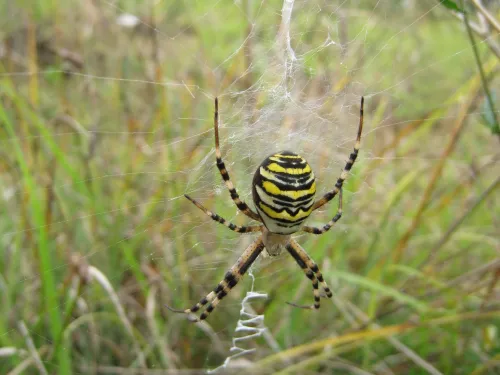Wasp beetle
A clever mimic, the wasp beetle is black-and-yellow and moves in a jerky, flight-like fashion - fooling predators into thinking it is actually a more harmful common wasp. Look for it in hedgerows and woods in summer.
A clever mimic, the wasp beetle is black-and-yellow and moves in a jerky, flight-like fashion - fooling predators into thinking it is actually a more harmful common wasp. Look for it in hedgerows and woods in summer.

The wasp spider is a great mimic - looking just like a common wasp keeps it safe from predators, even though it is not dangerous itself. It can be found in southern England, but is spreading north.
Look for Water avens in damp habitats, such as riversides, wet woodlands and wet meadows. It has nodding, purple-and-orange flowers that hang on delicate, purple stems.
As its name suggests, Water dock likes damp places, such as the egdes of canals, ponds and rivers. It is a tall plant with large, greenish flower spikes.
Water figwort is a tall plant of riverbanks, pond margins, damp meadows and wet woodlands. Its maroon flowers are pollinated by the Common wasp.
Also known as 'Scorpion-grass' because of the curved 'tail' at the end of its stems, Water forget-me-not is a distinctive plant of damp habitats. Over summer, it produces clusters of sky-blue flowers.
Water mint grows in damp places and has aromatic leaves that can be used to flavour food and drink. Gathering wild food can be fun, but it's best to do it with an expert - come to a Wildlife Trust event to try it.
From grunts and groans, to 'purring' and 'piglet squealing', the water rail is more often heard than it is seen! This shy bird lives in reedbeds and wetlands, hiding among the vegetation.
The water scorpion is not a true scorpion, but it certainly looks like one! An underwater predator, it uses its front pincer-like legs to catch its prey. Its tail actually acts as a kind of 'snorkel', rather than a sting, so it can breathe in the water.

The large, dark grey water shrew lives mostly in wetland habitats. It's a good swimmer that hunts for aquatic insects and burrows into the banks.
There are several species of spider that live in our wetlands, but the water spider is the only one that spends its life under the water. In its pond habitats, it looks silvery because of the air bubbles it traps in its hairs.
The water stick insect looks just like a mantis. An underwater predator, it uses its front legs to catch its prey. Its tail acts as a kind of 'snorkel', so it can breathe in the water. Look for it in ponds and lakes.